|
by Christina Luke, Department of Archaeology, Boston University Introduction: The region of upper Central America
includes the countries of Belize, El Salvador, Guatemala, Honduras,
while that of lower Central America includes the countries of
Nicaragua, C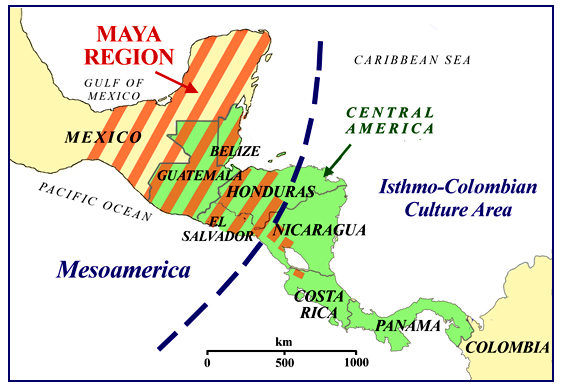 osta Rica, and Panama (figs.1,4). The entire region has a
rich past, most often celebrated for the areas that can claim links to
the splendid remains of the ancient Maya, in its fullest extent
occupying the area from southern Mexico (including the Yucatán
Peninsula) to Guanacaste, Costa Rica. The boundaries, then, of what
constitutes an ancient Maya cultural sphere and the modern boundaries
of Central America and Mexico overlap. osta Rica, and Panama (figs.1,4). The entire region has a
rich past, most often celebrated for the areas that can claim links to
the splendid remains of the ancient Maya, in its fullest extent
occupying the area from southern Mexico (including the Yucatán
Peninsula) to Guanacaste, Costa Rica. The boundaries, then, of what
constitutes an ancient Maya cultural sphere and the modern boundaries
of Central America and Mexico overlap. Fig.1:
Map showing the overlapping boundaries of the Maya region, which
occupies both southeastern Mexico and several Central American
countries. The eastern edge of the Maya region coincides with the
intersection of Mesoamerica and the Isthmo-Colombian Culture Area (also
called the Intermediate Area).
The remains of the Maya are indeed spectacular. The
Maya are one of the great ancient civilizations of the world —
complete with large city-states that boast monumental architectural
complexes used by the aristocracy as a governing base as well as for
public ceremonies. These centers were comprised of an array of people,
including artisans patronized by the wealthy to produce goods used
exclusively by the elite. Regional hamlets may have included nobles who
interacted with merchants as well as those collecting tribute on behalf
of the ruling centers.
In order to understand the ancient Maya,
archaeologists rely on context — the exact location of remains.
Context affords us a glimpse into the past to understand the ancient
systems of economic and political organization, the production of the
arts, and the spiritual realm that influenced daily life as well as
those in seats of power. Without context, we lose critical information
about site development and regional alliances (see Introduction,
pp.18-26).
While archaeologists value context as an essential
framework for site interpretation, art historians often pay scant
attention to it. Since many
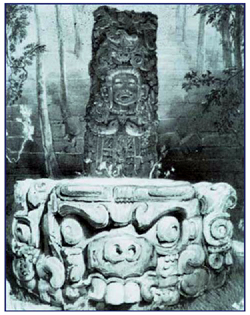 museums
have had policies of acquiring
antiquities without much concern for context, this has effectively
encouraged the antiquities trade, which runs directly counter to the
interests of both archaeologists and the host countries
of archaeological sites. One of the most acute examples of this is
the
illegal trade in Maya stelae (see below). museums
have had policies of acquiring
antiquities without much concern for context, this has effectively
encouraged the antiquities trade, which runs directly counter to the
interests of both archaeologists and the host countries
of archaeological sites. One of the most acute examples of this is
the
illegal trade in Maya stelae (see below). Fig.2: Stela D from the north side of the Great Plaza at Copán, Honduras, rising 12 ft beside an altar with a death god effigy, drawn by Frederick Catherwood in 1839 (Stephens and Catherwood 1841). The looting of archaeological sites throughout the
Maya region is consequently of grave concern. It is through regional
education and more broad reaching legislative efforts that we can
combat this illicit activity. Central America makes a good case study
for a critical analysis of looting and the respective legislative
efforts precisely because the culture most often touted – the
Maya – is not confined to one modern nation state; the US has had
long-term legislation in place for Central America beginning with the
1972 Pre-Columbian Monumental Architectural Sculpture and Murals
Statute. The US has also more recent legislation aim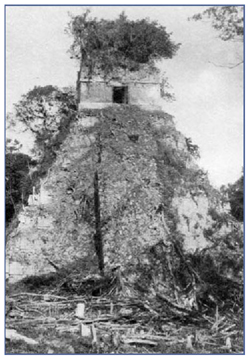 ed at specific
types of artifacts in Central America. Furthermore, countries in this
region have had legislation aimed at protecting cultural heritage for
many years, almost always preceding legislative efforts by the US. The
crux of this analysis will focus on these issues, emphasizing a
regional approach to the protection of cultural heritage and a
concerted effort to implement legislation at borders. This analysis
begins with the collecting of monuments, particularly the egregious
plunder of monumental sculptures and their subsequent purchase and
display by major US institutions. I then turn to an analysis of current
legislation and the role of the contemporary collector in the
increasingly exposed world of the antiquities trade. ed at specific
types of artifacts in Central America. Furthermore, countries in this
region have had legislation aimed at protecting cultural heritage for
many years, almost always preceding legislative efforts by the US. The
crux of this analysis will focus on these issues, emphasizing a
regional approach to the protection of cultural heritage and a
concerted effort to implement legislation at borders. This analysis
begins with the collecting of monuments, particularly the egregious
plunder of monumental sculptures and their subsequent purchase and
display by major US institutions. I then turn to an analysis of current
legislation and the role of the contemporary collector in the
increasingly exposed world of the antiquities trade.
Fig.3: Photo of Temple I at Tikal from the 1890s (Alfred Maudsley).
Broad considerations of the archaeologist: tourism
and the antiquities market: Exploration of archaeological sites in
Central America began in the early 1800s, including the well-documented
findings of Stephens and Catherwood in the 1830s-40s (fig.2; see also
papers in Boone 1993; Chinchilla 1998). By the late 1890s, sites in the
region had received attention from the German, French, British and
American scholarly communities, as exemplified by Alfred Maudslay
(fig.3). In the US the Peabody Museum of Archaeology and Ethnology at
Harvard University became one of the major institutions backing
research in the region, followed by the University Museum (now the
University of Pennsylvania Museum of Archaeology and Anthropology), the
Smithsonian Institution and the Carnegie Institution, among others. The
goal was to understand the culture history of the Maya world.
Subsequent research led to breakthroughs in the decipherment of Maya
hieroglyphics, the astronomical recordings and iconographic systems,
and an understanding of Maya settlement patterns. In recent years, we
have come to understand the ancient Maya through a more holistic lens
as a group of cultures that shared a worldview, an ideology, of which
each specific community adopted certain aspects. The extent of this
wide-reaching symbolic system includes areas that are not considered
Maya per se due to variations in material culture, but are encompassed
under the more general culture area of Mesoamerica (fig.1).
With the increased attention on the Maya world
within Mesoamerica, many other cultural spheres have been subsumed
within the broader label of Maya. These spheres include modern
indigenous Maya groups, often viewed by the tourism industry as somehow
frozen in the past (Arden 2004). Today, just as in the past, the diversity represented within Maya communities is tremendous and there
is resistance to the holistic “lumping” of all Maya into
one cultural sphere (see 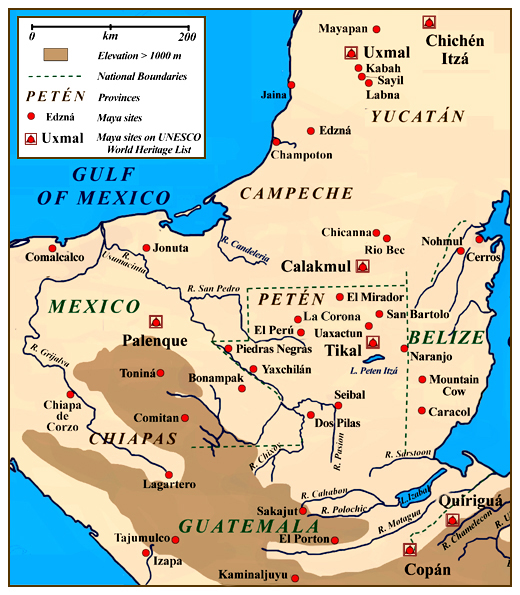 Mortensen 2006). Thus, there is a growing
interest in how we as archaeologists recognize the impact of our
research on not only our interpretations of the past, but also on the
contemporary communities (Joyce 2003). Mortensen 2006). Thus, there is a growing
interest in how we as archaeologists recognize the impact of our
research on not only our interpretations of the past, but also on the
contemporary communities (Joyce 2003).
Subsumed within these considerations is the
protection of archaeological sites in Central America. Precisely
because ancient boundaries of the Maya world do not correspond to
modern nation states, the countries of Central America must work
together towards an integrated plan aimed at cultural preservation.
This common goal has become increasingly apparent in recent years.
Fig.4:
Map showing central portion of the ancient Maya region. Seven major
sites have been designated world heritage resources by the United
Nations UNESCO agency.
The largest sites or the most
“unique” are those covered under the UNESCO World Heritage
list. Those with a direct claim to the Maya, specifically the Late
Classic period (AD 600-800), are most often celebrated on the tourist
routes: La Ruta Maya program launched by National Geographic in 1989,
now called El Mundo Maya, is a planned tourist circuit through the
region to the most prestigious Maya ruins. In this way academic
scholarship plays a vital role: it is this scholarship that defines how
we perceive the ancient Maya and, thus, which areas are developed for
tourism (Joyce 2003).
An emphasis on local education and involvement of
local communities is one approach to site protection; it serves to
integrate the communities aimed at sustainable tourism. It also
promotes a dialogue of exchange regarding the significance of the past
and the importance of context. These efforts have a solid up-hill
battle, a battle against the trade in antiquities. While some have
argued that the trade in antiquities would be eradicated if regional
poverty declined (Matsuda 1998), I have argued that the trade is
endemic, able to flourish precisely because the collecting community
values aesthetics over context 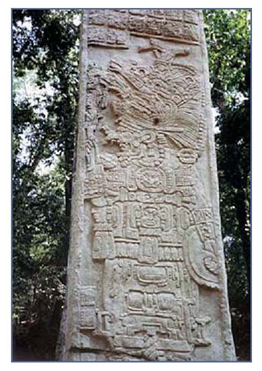 (Luke and Brodie 2006; Luke 2006; Luke
and Kersel 2005; Luke and Henderson 2006). In fact, an analysis of the
sale of Maya materials at Sotheby's from 1970 to 1999 (Gilgan 2001)
confirms that archaeological context (the horizontal and vertical
position of an artifact) has never been a consideration for the trade:
objects are bought and sold regardless of whether their archaeological
context is known. Contrary to growing talk of the value of context by
the trade, there does not appear to be a higher market value for
objects from the Maya region. Recent data indicate that this trend has
continued (Gilgan, personal communication, 2005). (Luke and Brodie 2006; Luke 2006; Luke
and Kersel 2005; Luke and Henderson 2006). In fact, an analysis of the
sale of Maya materials at Sotheby's from 1970 to 1999 (Gilgan 2001)
confirms that archaeological context (the horizontal and vertical
position of an artifact) has never been a consideration for the trade:
objects are bought and sold regardless of whether their archaeological
context is known. Contrary to growing talk of the value of context by
the trade, there does not appear to be a higher market value for
objects from the Maya region. Recent data indicate that this trend has
continued (Gilgan, personal communication, 2005).
Fig.5: Stela 15 from El Duende area of Dos Pilas before looting (photo: Stanley Guenter; Courtesy of Mesoweb)
What is more, Sotheby’s does watch the
legislative efforts closely, changing an object’s attributed
regional provenience depending on the current legislation. In 1991 an
Emergency Agreement between the United States and Guatemala went into
force for material from the Petén – area of the Guatemala
Lowlands that was once the heartland of the most celebrated Maya sites.
Sales at Sotheby’s did not decline, but the label of
“Petén” was dropped, replaced by the more ambiguous
“Lowlands” designation (Gilgan 2001). This shift of
terms/vocabulary high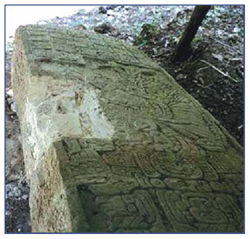 lights two issues: the market is sensitive to
legislative efforts and there is clearly a need for broad-reaching
legal instruments, rather than country-by-country legislation. The
Petén region, located in the northern lowlands, is definable and
more or less specific to Guatemala. Yet, the Petén is part of
the broader “Lowlands”; hence the shift of the label
allowed Sotheby’s to evade the legislation and continue business
as usual. lights two issues: the market is sensitive to
legislative efforts and there is clearly a need for broad-reaching
legal instruments, rather than country-by-country legislation. The
Petén region, located in the northern lowlands, is definable and
more or less specific to Guatemala. Yet, the Petén is part of
the broader “Lowlands”; hence the shift of the label
allowed Sotheby’s to evade the legislation and continue business
as usual.
Fig.6:
View of damage done by looters to Stela 15 from El Duende area of Dos
Pilas (photo: Stanley Guenter; Courtesy of Mesoweb).
Looting the Maya world: The looting of the Maya
World is real, and it is egregious. Monuments are smashed or
deliberately sawed in parts, the parts reunited once in the
collector’s home or institution. Architectural structures show
massive scars from the rape of history: large trenches penetrate deep
into the structures, undoubtedly evidence of those searching for royal
tombs, a common feature in many Maya temples. Once found the tombs are
ransacked by looters who take the perceived marketable items, leaving
the rest behind, often scattered across the landscape, broken into
pieces.
For many years, looting operations were believed to
be clandestine in nature. In recent years this trade has taken on a new
face (or this face has now been exposed): an “order” market. In 1997 National GeographicNational Geographic publication.
Stelae at Dos Pilas: Another example of this type of
deliberate, focused looting comes from the site of Dos Pilas. El Du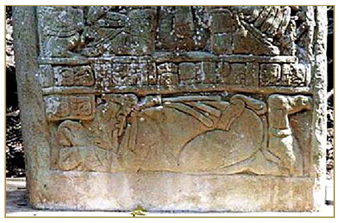 ende
Complex was the target, an area outside the main center commissioned by
Itzamnaaj K’awiil (AD 697-726). Here on December 12, 2003, stela
15 was violated: the small scepter held by the main ruler was removed,
leaving behind a gaping hole in the large monument (figs.5,6). This
precise target indicates that there is a market for a specific part of
this monument. ende
Complex was the target, an area outside the main center commissioned by
Itzamnaaj K’awiil (AD 697-726). Here on December 12, 2003, stela
15 was violated: the small scepter held by the main ruler was removed,
leaving behind a gaping hole in the large monument (figs.5,6). This
precise target indicates that there is a market for a specific part of
this monument.
Fig.7: Stela 14 from El Duende area of Dos Pilas before looting (photo: Stanley Guenter; Courtesy of Mesoweb)
A similar situation is also true of stela 14: the base
of the monument was removed – specifically the hieroglyphic text
and the bound captive (figs.7,8). Too large to haul away, this section
was left behind, the damage to the monument 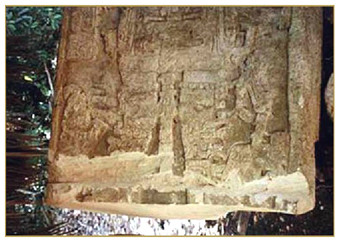 complete
published a piece by David Stuart on the royal graves at Copan, Honduras. Included in the issue were photographs of the finds —
still in context — from the tomb. In February, 1998 the entire
area was plundered (Agurcia 1998). The finds that were taken suggested
that the people responsible for the looting had seen the (see Guenter 2004 ). complete
published a piece by David Stuart on the royal graves at Copan, Honduras. Included in the issue were photographs of the finds —
still in context — from the tomb. In February, 1998 the entire
area was plundered (Agurcia 1998). The finds that were taken suggested
that the people responsible for the looting had seen the (see Guenter 2004 ).
Fig.8: Stela 14 from
El Duende area of Dos Pilas after base was cut off by looters (photo:
Stanley Guenter; Courtesy of Mesoweb)
Stelae at El Perú: The hacking apart of Maya
sculpture is not new. Numerous Maya-style stelae exhibit evidence of
the deliberate sawing-up of the monument and then the rejoining of
parts. Many of these damaged, but at least “complete,”
stelae can be found at the most prestigious museums in the United
States: the two stelae portraying females at the Cleveland Museum of
Art and a stela at the Kimbell Art Museum (fig.9), among others. Here
the clean saw marks that cut through these stelae provide evidence of
malicious plunder events and serve as tell-tale signs of how such large
monuments were made portable.
Both of the stelae at the Cleveland Museum of Art
represent royal women. Such public displays of women are rare in Maya
monumental art, but are essential for our understanding of access to
power. Rulers often traced their royal bloodlines (or perceived royal
bloodlines) through the matrilineal line and in several cases, royal
women appear to have founded dynasties. The iconographic
representations of these prominent women, then, provide a lens into a
highly charged and negotiated political landscape of the Late Classic
period. The plaque placed near the stelae clearly shows how proud the
museum is to have not just one example of a royal woman, but two:
“The Maya devoted much stone sculpture to royal portraits,
usually of men. The museum is fortunate to have two reliefs that
feature noble women…”
The only provenience given for one of the stela is
“Mexico or Guatemala, Usumacinta River region, Maya style
(250-900).” Given the importance of women and the relatively rare
occurrence of their representation, the plunder of these stelae is
particularly appalling. The other stela is attributed to El
Perú:
"She originally stood in a plaza between depictions of men, one probably
her husband, ruler of the provincial Maya town El Perú...
According to hieroglyphic texts, her importance stemmed from her family
background. She came from a ruling dynasty at another Maya center,
Calakmul, that was more powerful than her husband's; through
marriage, he probably gained potent allies."   
The remaining part of the museum text details the
stylistic details of the piece as a work of art and the information
contained within the hieroglyphic text. It was the work of Ian Graham
that proved that the stela was in fact from El Perú. He found
the matching remains in the main plaza, effectively re-contextualizing
the stela and, thus, allowing for the detail now on the museum plaque. in fact from El Perú. He found
the matching remains in the main plaza, effectively re-contextualizing
the stela and, thus, allowing for the detail now on the museum plaque.
Another of El Perú’s stelae is at the
Kimbell Museum in Forth Worth, Texas, acquired by the museum on the New
York art m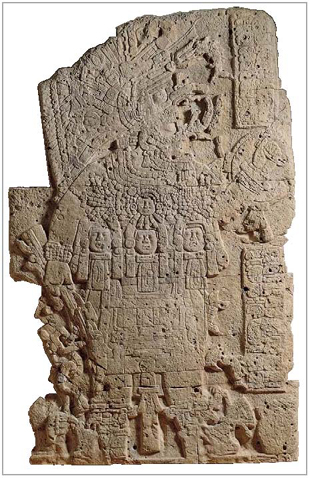 arket in the late 1960s arket in the late 1960s . There is no description of the site
of El Perú, only general reference to the importance of stelae
and a sentence directing you to Cleveland, “The Maya set up
official portraits like this . There is no description of the site
of El Perú, only general reference to the importance of stelae
and a sentence directing you to Cleveland, “The Maya set up
official portraits like this one in ceremonial courtyards of
pyramid-temples. This stela is one half of a pair of so-called marriage
portraits that depict a male and female ruler (fig.9). The mate to this
piece is in the collection of the Cleveland Museum of Art.” This
stela, like those at Cleveland, is in pieces, reassembled for display,
reflecting the destructive methods employed to remove and transport it
from the site. one in ceremonial courtyards of
pyramid-temples. This stela is one half of a pair of so-called marriage
portraits that depict a male and female ruler (fig.9). The mate to this
piece is in the collection of the Cleveland Museum of Art.” This
stela, like those at Cleveland, is in pieces, reassembled for display,
reflecting the destructive methods employed to remove and transport it
from the site.
Fig.9:
Stela 33, the mate of Stela 34, kept in the Kimbell Museum in Fort
Worth, Texas. This sculpture, looted from the site of El Perú, displays
a ruler standing with his scepter and tasseled shield. By wearing the
regalia of the gods, the ruler is sanctified as the nurturer of his
people. Limestone, 107-3/8 x 68-3/8 in., acquired in late 1960s (photo © Kimbell Art Museum, Fort Worth, Texas).
These stelae and others in museum and private
collections around the world were acquired in the 1960s, a period of
increased plunder in the Maya world. Clemency Coggins brought the
situation to light in her 1972 article, “Archaeology and the Art
Market,” published in Science. She published not only a critical
summary of the problem, but also the photographs of cut-up stelae parts
in suitcases! The result of Coggins' research and efforts led to the
1972 Pre-Columbian Monumental Architectural Sculpture and Murals
Statute (discussed below). Yet, the market, at least the public market,
made adjustments again. As Gilgan’s (2001) research points-out,
the sales at Sotheby’s over the years have focused on movable
objects with few monuments or parts of monuments put up for public
auction.
Site Q: While not offered on the public market, Maya
stelae continue to be looted, as the cases from Dos Pilas above
indicate. The impact on scholarship from looting in the 1960s as well
as more recent events is real. For example, in the 1960s a series of
hieroglyphic texts (at least two dozen), presumably from such monuments
or facades, appeared on the market. A number of museums purchased the
sculptures, including the Art Institute in Chicago (fig.10). The
decipherment of the texts on those monuments at Chicago described a
prominent Maya center, known for years as the mysterious Site Q. Many
of the texts were incomplete, yet e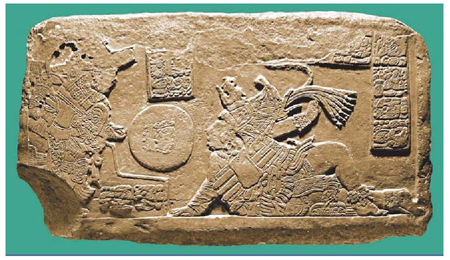 pigrapher Peter Matthews, who looked
at the corpus as a whole (i.e., putting all the broken parts together),
noticed that the texts were indeed complete. The details of the
hieroglyphic and iconographic work led to various interpretations of
the political order of the greater central Lowlands (Schuster 1997). pigrapher Peter Matthews, who looked
at the corpus as a whole (i.e., putting all the broken parts together),
noticed that the texts were indeed complete. The details of the
hieroglyphic and iconographic work led to various interpretations of
the political order of the greater central Lowlands (Schuster 1997).
Fig.10:
One of six known looted ballplayer panels that may have adorned a
staircase at site Q. An inscription above the righthand ballplayer identifies him at Red Turkey, a name that also appears on two stela
fragments at La Corona (fig.4) in the Late Classic period. (Limestone, h. 43.2 cm x w. 25.1
cm; Ada Turnbull Hertle Fund, 1965.407) (photo © Art Institute of Chicago).
Suggestions had been made that La Corona was indeed
Site Q, and in 2005 a discovery at the site of an in situ hieroglyphic
text (finally) confirmed that La Corona was the mysterious site.
In fact, it was the placement of the looter’s trench that led to
the discovery of the hieroglyphic text by Marcello Canuto; as recounted
by Guenter, “He’d been taking GPS points on a number of
pyramids in the eastern part of the site so we could check them against
our map. He had had trouble with his GPS unit and just set it on the
side of a looters’ trench and decided to nose around. And
that’s when he noticed the carved stone” (Guenter 2006).
This find (with context) has at last placed the sculptures on the
landscape in the antiquity, even if many of the two dozen sculptures
remain “lost,” buried deep within the black market or in
the private collections, perhaps bank vaults, of their
“owners.”
Looting of Maya sites destroys more than just the
hieroglyphic record. It destabilizes structures, exposing contexts that
while unmarketable for looters, are precious windows into the past. The
recent surge of research at the site of San Bartolo has redefined our
understanding of early occupation and social and political life in the
central Lowlands. San Bartolo had been the focus of numerous looting
efforts: the large abandoned trenches exposed an early Classic Maya
mural. The mural was in situ,
now exposed to the elements. The chance find of the mural in a
looter’s trench by William Saturno set in motion a large-scale
research program backed by National Geographic.
Subsequent professional excavation has uncovered the earliest known
hieroglyphic text of the region, some 300 years earlier than previously
documented.
This situation highlights the numerous issues
associated with the antiquities trade. If left without proper
attention, looted contexts will only cause further destruction to
monuments, and their associated finds, such as stucco facades, murals
or other movable goods, will succumb to the rain, wind, open air, etc.
Yet there is a deeper problem as well. In all the news articles
reporting San Bartolo and La Corona, the trade in antiquities is only
mentioned in passing and no real attention has been paid to the real
need to document all looting trenches systematically. There has yet to
be real public out-cry from the archaeological community, demanding
further protection and enforcement of legislation or a focused push to
treat evidence of looting in the field with a systematic approach.
Ulúa Marble Vases: A final consideration for
review here is movable materials. Ulúa marble vases (figs.
11-13) from the Lower Ulúa Valley of northwestern Honduras are
among the most sought-after items on the antiquities market. Only a
handful has been excavated in truly professional contexts. The
remaining 200+ are scattered in museums and private collections. The
appearance on the public market comes late, only after a museum
exhibition highlighting the fantastic nature of the vases (Luke and
Henderson 2006). Rather, the plunder for such vases was driven 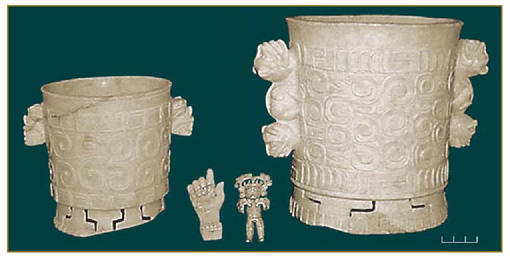 by
museums, mostly US institutions, and private collectors, documented as
early as the late 1890s (Luke 2006) with a substantial rise in demand
during the 1960s and 1970s. Furthermore, the trade labels the vases as
Maya, yet many consider the region to be a frontier zone, not strictly
Maya. by
museums, mostly US institutions, and private collectors, documented as
early as the late 1890s (Luke 2006) with a substantial rise in demand
during the 1960s and 1970s. Furthermore, the trade labels the vases as
Maya, yet many consider the region to be a frontier zone, not strictly
Maya.
Fig.11: Two Ulúa style marble vases, one gold figure, and one jade hand of the Santa Ana Corpus (photo: courtesy of the Middle American Research Institute, Tulane University).
The prices for these vases are indeed high for
material from the Ulúa region: ca. $60,000 per vase. The
exposure of the region through a cademic scholarship, particularly links
to the central Maya lowlands, is promoting the area in the trade and
driving prices higher, particularly for ceramics. Yet, plunder
continues, further obliterating what little is left of the
archaeological sites in the area, many completely destroyed (Luke and
Henderson 2006). cademic scholarship, particularly links
to the central Maya lowlands, is promoting the area in the trade and
driving prices higher, particularly for ceramics. Yet, plunder
continues, further obliterating what little is left of the
archaeological sites in the area, many completely destroyed (Luke and
Henderson 2006).
Fig.12: Two Ulúa style marble vases of the Peor es nada corpus (photo: courtesy of the Middle American Research Institute, Tulane University).
The market for Pre-Columbian movable materials
– fancy jades and ceramics – is anything but quiet.
Christie’s has opened a new auction house in Paris, France.
Recent sales at Sotheby's in New York show values for a single
polychrome vase between $200,000 and $250,000, and $1,575,500 for an
Early Classic Maya Jade at Christie's in their November 200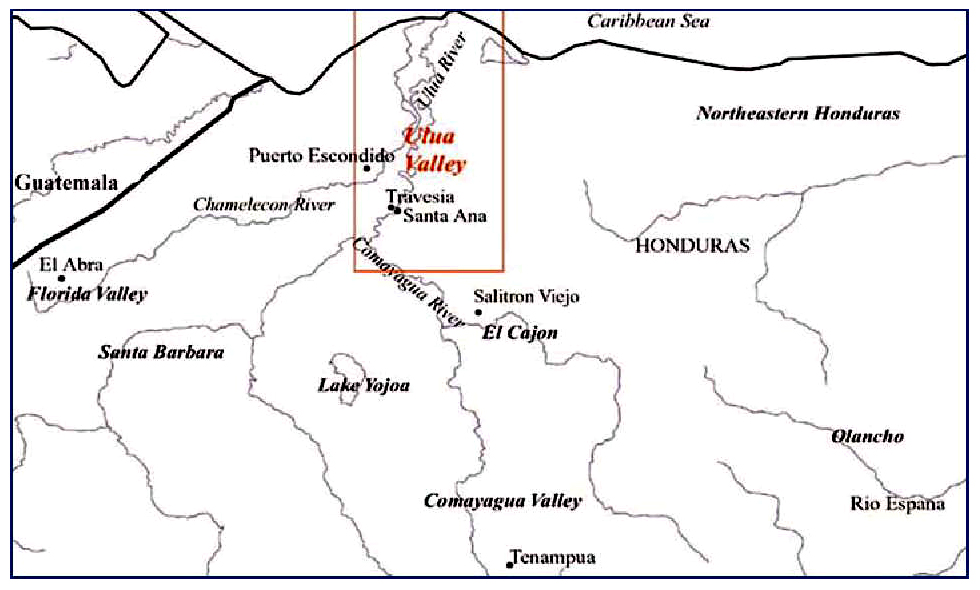 4 sale. Such
prices have traditionally been reserved for materials from the
Classical world. The cases presented here only scrape the surface of
the truly tragic situation facing the region of Central America. 4 sale. Such
prices have traditionally been reserved for materials from the
Classical world. The cases presented here only scrape the surface of
the truly tragic situation facing the region of Central America.
Fig.13: Map of the Ulúa Valley and surrounding areas in Honduras and Guatemala (Luke 2005).
Recent debate: With all the
looting and the rise in market prices, what can be done to ensure that
sites are not looted? While the outspoken pro-trade, legal expert John
Merryman and others contend that the trade in materials should be legal
precisely because these objects constitute world cultural heritage and,
thus, should not be controlled by the modern nation states that subsume
the sites, this camp appears to disregard their own argument when it
comes to the protection of archaeological sites. An object is an
object, regardless of whether it has context or not. Yet an object can
be a direct lens into the past if it, as well as its context, is
preserved. This holistic approach emphasizes that context must be the
primary concern, the study of the artifact a natural corollary. Thus
the very paradigm that is often used as an argument to open trade in
antiquities, to promote museum exhibitions for educational purposes, is
in fact the key problem. The world archaeological record must be
protected and yet this is frustrated by the trade, which is dead-set on
backing statements that value the object over context, thus dismissing
the importance of the archaeological site. This seems to deflate
credibility more than it appears to help and points to the ignorance of
not only those in the trade, but also those in the upper echelons
making decisions.
This debate has been a long-standing issue with
museum acquisitions, both from direct sale and from donations from
patrons. The material from the Landon T. Clay collection in the Museum
of Fine Arts in Boston is an example specific to material from
Guatemala (fig.14). In the late 1980s, the museum accepted a number of
objects from Clay. Guatemala strongly believes that the material was
looted from the Petén and, hence, should be returned to
Guatemala. Restitution of the objects remains unresolved.
This standstill with Guatemala may change in coming
years, particularly with the current spotlight on museums and their
acquisition policies at auction and from donors. Both the MFA and the
Metropolitan have been involved in detailed negotiations with the
Italians, following the explosion onto the antiquities radar of the
trail of former Getty Museum curator, Marion True (see Introduction,
pp.22-24; and Case Study 2, pp.32-38). In February, 2006 the
Metropolitan agreed to return twenty-one artifacts to Italy, including
the celebrated Euphronios krater (pp.27-30). Subsequently, on
September 28, 2006, the MFA Boston signed a similar agreement with
Italian officials, resulting in the return of thirteen culturally
significant objects such as the six-foot Greek marble statue of Sabina
(Edgers and Pinto 2006). The Getty Museum, meanwhile, has returned some
artifacts to Greece and Italy and has recently conceded its prize
artifact, a statue of Aphrodite purchased for $18 million in 1988,
which the Italians claim was looted from Morgantina in Sicily (see
pp.32-38).
While the restitution of objects is the subject of
an entire paper, if not book, some press statements on the issue
highlight the troubling lack of concern of the trade, and perhaps much
of the museum world, to context. Metropolitan Museum Director Phillip
de Montebello, for example, laments the plunder of archaeological
sites, but he clearly does not view the central importance of context
as an archaeologist would see it. In an interview published in the New
York Times (Kennedy and Eakin 2006), Montebello said, “It
continues to be my view – and not my view alone – that the
information that is lost is a fraction of the information that an
object can provide…Ninety-eight percent of everything we know
about antiquity we know from objects that were not out of digs.”
His specific example related to the highly contested Euphronios krater:
“How much more would you learn from knowing which particular hole
in – supposedly Cerveteri – it came out of?” he
asked. “Everything is on the vase” (Kennedy and Eakin 2006;
see also Case Study 1, pp. 27-30). From an archaeologist’s
perspective, these comments provide a nearly perfect illustration of
the scant attention paid to context in the museum world. Yet a much
fuller realization and acceptance of the direct relation between
context — or its obscurance — and legal vs. illegal status
of imported artifacts is urgently required, especially by museum
spokesmen. If museums would be both informed about illegal artifact
trade, and held accountable for avoiding the purchase of illegally
smuggled artifacts, this would introduce a necessary criteria of
illegal vs. legal context that all museum officials would need to learn.
Legislation in Central America: In most cases, the
countries of Central America including Mexico have had laws that govern
cultural patrimony for over a century (see Table 1). The respective
legislation in many cases corresponds to exploration and archaeological
research by foreigners, usually under the auspices of a major
institution, such as the British Museum or the Peabody at Harvard. For
example, protection for the site of Copan in Honduras was triggered in
1836 by the work of John Lloyd Stephens, most likely by his purchase of
the site, later revoked. Guatemala, too, had early laws, among the
first in Central America (Chinchilla 1998). Over the years institutions
wrestled against each other, all attempting to transport monuments back
home. Faced with transportation difficulties, they developed a method
of making plaster casts, thus allowing the remains to stay in place
while bringing home a sort of replica. This would seem to be an ideal
situation, yet many of the monuments have since been destroyed by the
antiquities trade, such as monuments from Piedras Negras (fig.4), so that now
only the plaster casts at the Peabody allow us to see their once intact
state.
These early laws defined what constituted cultural
patrimony in the respective region as well as established guidelines
for foreign institutions wishing to conduct excavations. In most cases,
the finds were divided evenly between the host nation 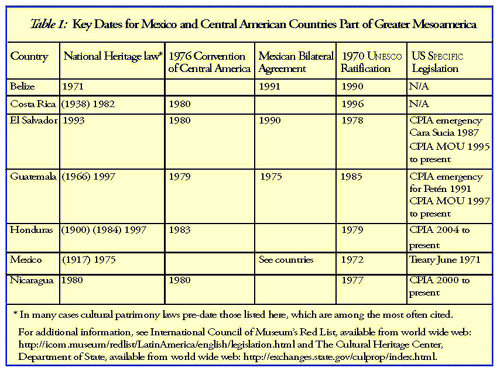 and the
sponsoring institution. This was certainly the case in Honduras during
the early decades of the 20th century. Yet with the increasing
awareness of archaeological context and need for site preservation,
countries began to change their positions, restricting the export of
any materials. For Honduras, the border was closed under a 1936 law,
yet material continued and continues to move clandestinely out of the
region (Luke 2006). and the
sponsoring institution. This was certainly the case in Honduras during
the early decades of the 20th century. Yet with the increasing
awareness of archaeological context and need for site preservation,
countries began to change their positions, restricting the export of
any materials. For Honduras, the border was closed under a 1936 law,
yet material continued and continues to move clandestinely out of the
region (Luke 2006).
In the late 1960s and the early 1970s, the
international focus turned to the 1970 UNESCO Convention on the Means
of Prohibiting and Preventing the Illegal Import, Export and Transfer
of Ownership of Cultural Property, and countries began to take a closer
look at national ownership laws, particularly how (and if) they
discerned between export regulations and full declaration of ownership.
These two issues continue to be among the most important for
prosecution of a case under US law.
For example, in 1984 Honduras put into place the Law
for the Protection of Cultural Patrimony (legislative Decreto No.
81-84), firmly establishing both export and ownership provisions in the
law. This law, like many laws in Central America [e.g., Guatemala
(Decree 26-97) and El Salvador (Decree no.513)], recognizes
unambiguously cultural patrimony as property of the state and enforces
strict regulations for its excavation (i.e., application for work under
a permit process). Yet these laws often allow for the transfer of
cultural patrimony (for sale or as gifts) between private individuals
and/or institutions within the country, provided that the material
patrimony and its location are registered with the Ministry of Culture
or designated government entity/institution. Thus, in theory, an active
and legal trade is possible within the country. Honduras broke with
this model in 1997 with the passage of Decree 220-97, which forbids the
sale or transfer of cultural patrimony as well as the possession of
cultural patrimony within state borders. The law is retroactive. The
only provision is that objects may stay in collections until the death
of the current patron, but they may not be transferred through
inheritance.
Central American countries have also reached out to
their neighbors in attempts to have regional cooperation to thwart the
illicit traffic of antiquities over borders. All are party to the 1970
UNESCO and none have additional implementing legislation, as is the
case with many “market” countries. As a party member, these
countries of Central America as well as Mexico pledge to uphold their
respective cultural patrimony laws. In addition, all, save Belize and
Mexico, are party to the 1976 Convention on the Protection of the
Archaeological, Historical and Artistic Heritage of the American
Nations. Yet, Belize and Mexico have a bilateral agreement with each
other, as does Mexico with Guatemala and El Salvador. Thus, while
Mexico may not be party to the 1976 Convention, it has taken steps to
ensure that those countries it shares borders with do have legal
instruments that pertain to cultural patrimony.
Finally, an international convention that has been
gaining favor once again is the 1995 UNIDROIT Convention on the Return
of Stolen or Illegally Exported Cultural Objects. UNIDROIT, unlike
UNESCO, makes no distinction between plunder and theft, providing an
opportunity for countries to pursue legal action under existing stolen
property instruments. In the last six years both El Salvador and
Guatemala have become parties.
Legislation from the US perspective: As shown in the
few examples provided in this paper, the United States is one of the
largest market countries for antiquities from Central America and
Mexico (as well as other materials from around the world). While sales
throughout Europe may be (and probably are) higher than those in the
US, Europe isn’t a country per-se and, hence, can’t be
regulated under the guise of a nation-state model. Even if the European
Union decided on broad-sweeping legislation, Switzerland, a key node in
the antiquities trade, is not a member state. Switzerland is often
touted as the key place to launder title because, until recently, the
Swiss allowed looted antiquities to pass through their borders, thus
providing an opportunity to mask the dirty history of an object. The
close proximity of a large US market for materials from Central America
and, particularly, Mexico makes the United States desirable for those
trafficking in antiquities. The traditionally porous US border with
Mexico has made for an easy transit route, as have the multiple direct
shipping routes and direct airline flights from Central America to US
ports of entry.
With the vibrant trade, it is no surprise that the
US does have a number of legal instruments that pertain to cultural
patrimony in Central America and Mexico. Two of these are over thirty
years old: the 1970 Treaty of Cooperation between the United States of
America and the United Mexican States Providing for the Recovery and
Return of Stolen Archaeological, Historical and Cultural Properties and
the 1972 Pre-Columbian Monumental and Architectural Sculpture and
Murals Statute (date of enforcement June 1 1973). The US-Mexico Treaty
is more comprehensive than the Pre-Columbian Statute for material
within the boundaries of Mexico. In addition to archaeological goods,
the US-Mexico Treaty covers historical materials, which includes
colonial period materials, demand for which is growing. Furthermore,
Mexico has a national ownership law and it has been upheld by the
United States under the National Stolen Property Act of 1946, known as
the McClain Doctrine (see below).
The 1972 Pre-Columbian Monumental and Architectural
Sculpture and Murals Statute is particularly effective, at least in
theory, because it is regional in coverage, not specific to
nation-states, unlike the US-Mexico Treaty or the various bilateral
agreements with the US (see below). The focus of a statute on the
material, rather than the state, alleviates the need to correspond
ancient and modern boundaries. The specific nature of this statute is
clearly presented in the US Code of Federal Regulations for Customs
Officers, the actual implementing documents. Yet in reviewing the US
Customs and Border Protection, “Special Rules of Protected
Cultural Property” section (p. 14), specific country names have
crept into the guidelines. With regard to this statute the compliance
publication states that such materials “are the product of a
Pre-Columbian Indian culture of one of the following countries: Belize,
Bolivia, Columbia, Costa Rica, Dominican Republic, Ecuador, El
Salvador, Guatemala, Honduras, Mexico, Panama, Peru or
Venezuela…” In addition to problems with translation from
one document to the next, this highlights a fundamental attempt to
favor modern boundaries over ancient ones, undermining the very nature
of the statute.
The Pre-Columbian Statute does not cover movable
items that are not sculptures or murals or parts there of. Yet these
materials constitute much of the archaeological record: ceramic
vessels, ceramic figurines, stone tools, stone jewelry, stone vases,
and items made of shell. There is additional legislation in the United
States for these types of objects. Unlike the Pre-Columbian Statute,
however, such legal instruments are country specific.
CPIA and MOU: Under the 1983 Cultural Property
Implementation Act, the implementing legislation for the 1970 UNESCO
Convention in the United States, there are several ways of stopping
material at the US border. The CPIA implements the 1970 UNESCO articles
7b and 9. Article 7b focuses solely on stolen materials; that is,
materials that have been inventoried from a collection and/or
excavation. The US agrees to stop stolen materials from any state party
to the 1970 UNESCO Convention. Article 9 deals with materials that have
been plundered and, hence, lack context. Yet, in order for material to
be stopped at the US border, the modern nation state where the material
in jeopardy resides in the ground must formally ask the US for a
bilateral agreement or what is commonly referred to as an MOU
(Memorandum of Understanding) (see Luke and Kersel 2005).
The process of requesting a MOU is not easy. A
country’s request must address four points: pillage is a
problem; efforts are in place to combat pillage; the US market is part
of the problem; and the history in question is valued by the
international community (e.g., interest in archaeological research in
country and/or loans of material for international exhibitions). A
request must be submitted via diplomatic channels, usually transferred
in writing to the in-country US Embassy, but it may also be transferred
to the US via the respective country’s Embassy in Washington,
D.C., among other channels. The request is then reviewed by the
Cultural Heritage Office at the US Department of State and transferred
to the Presidential Cultural Property Advisory Board – a group of
experts in the fields of museums, archaeology, anthropology, and the
trade. The committee then recommends that an agreement be made or not.
The appointed decision maker makes the final determination. If the
decision is favorable, the country enters into an agreement, a formal
MOU. This process can take 2-6 years (or more) to complete; a MOU is a
five-year agreement that may be renewed multiple times. An emergency
agreement for a specific area may precede a formal MOU. At this time, a
number of Central American countries have MOUs (see Table 1). All such
agreements cover Pre-Columbian materials most likely to be pillaged,
but do not cover Colonial material (provision under the
“ethnographic” category of the CPIA), which the agreements
between the United States, Peru and Bolivia do cover.
Within the CPIA there is room for multilateral
agreements with other nation states. Such an option has never been
presented by a group of countries. Central America makes a good first
case precisely because many countries already have MOUs with the United
States. The benefit of a regional agreement would be to alleviate the
process of determining ancient vs. modern boundaries. One key issue for
Central America would be the implementing date for a multilateral
agreement, given that the various MOUs have a number of different dates
of enforcement.
A more clear-cut approach would be for countries
that share ancient cultural regions, such as those in the
Mediterranean, to apply for a multilateral agreement from the outset,
alleviating the country-by-country process and providing for more
effective coverage. For example, Greece and Turkey could approach
Cyprus and Italy – countries with MOUs – and ask for a
concentrated diplomatic effort with a region-wide approach.
Alternatively, these countries could side-step the CPIA process
entirely and focus on broad-sweeping legal instruments, such as the
Pre-Columbian Statute, geared towards specific types of objects,
monuments, etc.
Proper documentation: Both the CPIA and the
Pre-Columbian Statute mandate satisfactory evidence. What constitutes
proper documentation under the Pre-Columbian Statute is not specified.
Yet, when read closely, satisfactory evidence under the CPIA allows for
a good faith statement that “to the best of [the
importer’s] knowledge, the material was exported from the State
Party on or before the date such material was designated” under
the respective legislation. Ideally such statements should be
corroborated, really probing whether the importer is naïve enough
not to understand the egregious nature of plunder in so many source
countries. Making such claims is becoming harder and harder as more and
more legal cases involving key figures and institutions are highlighted
in the mainstream press. Furthermore, such naivety is clearly not
present in the dealing community. In fact, as Mackenzie's recent
chilling account describes, dealers know exactly what they are up
against and continue to operate, hedging their bets. An excerpt from
Mackenzie's (2005: 107) book highlights this sentiment:
[Would it be fair to say that if the information was available, where the objects were found, that would be of interest to you?]
Of course it would be of interest to me, and I desperately want to give
it, but I would have to caution it with “said to be"
or “allegedly from" because otherwise I could lose it. It's
obvious…
[What you can do, I think, is improve your mechanisms for recording and passing on provenance information.]
I've tried and I get hit for it. I've destroyed some of it out of fear. (Geneva Collector I)
The bottom line is that context doesn’t appear
to be valued enough for collectors to retain it when it is known and/or
ensure that objects have it, and they will go through many hoops to get
what they want: the object and/or money for the object. Again, an
excerpt from Mackenzie's book highlights this point:
If a collector wants a particular piece, a collector wants a particular
piece. That's why you'll find a lot of these sort of works are
literally going to an end collector who might have employed a dealer to
start doing the work, the searching for them. For instance, a person
might say look, they want a Maya head, they want this, this, this, and
this. And then they'll go off and they'll ask dealers and a dealer will
know someone who knows someone, and the next thing one gets pulled
away.
(Melbourne Dealer 2; from Mackenzie 2005: 144)
If indeed this sentiment is persuasive throughout
the dealing and collecting communities, as Mackenzie suggests, then,
the criteria for satisfactory evidence need to be pursued with great
vigor by law enforcement and their legal counterparts. If collectors
are willing to get material regardless of safeguards put in place by
various legal systems, is there any hope?
Court Cases: A violator of the CPIA or the
Pre-Columbian Statute in the United States is required to give over the
materials. These instruments are civil, not criminal. Under a positive
criminal prosecution the defendant may serve jail time. A number of
smuggling statutes and the National Stolen Property Act of 1946 are
criminal, and over the years they have been used against violators of
cultural property.
The National Stolen Property Act (NSPA) received
renewed attention after the conviction of Fredrick Schultz in 2003, the
former President of The Association of Dealers in Ancient, Oriental and
Primitive Art. In United States vs. Schultz, Schultz was convicted of
dealing in stolen goods from Egypt. This decision affirmed the McClain
case (United States vs. McClain) from the late 1970s involving Mexican
material. While the McClain doctrine is the most cited, another case,
also in the 1970s, has also been successfully prosecuted under the
NSPA, U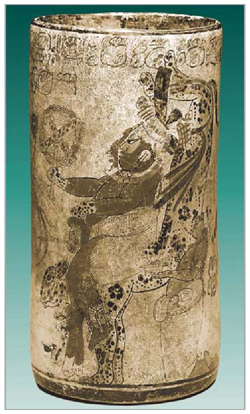 nited States vs. Hollinshead. In this case Hollinshead was found
to be in violation of the Guatemalan ownership laws for the taking of a
Maya stela from the territory of Guatemala. The defendants were part of
a smuggling ring moving Maya stelae out of Guatemala through the Belize
border and into the United States. The stelae were cut-up into pieces
and transported in boxes marked “personal effects”
(Gerstenblith 2001: 214, fnt. 65). nited States vs. Hollinshead. In this case Hollinshead was found
to be in violation of the Guatemalan ownership laws for the taking of a
Maya stela from the territory of Guatemala. The defendants were part of
a smuggling ring moving Maya stelae out of Guatemala through the Belize
border and into the United States. The stelae were cut-up into pieces
and transported in boxes marked “personal effects”
(Gerstenblith 2001: 214, fnt. 65).
Fig.14:
Maya vase of the Landon T. Clay collection, which may have been looted
from the Petén region of Guatemala. The vase is currently kept at the
Museum of Fine Arts in Boston. Late Classic period AD 725-760 (photo © Museum of Fine Arts, Boston; Gift of Landon T. Clay).
In all of these cases the court found that each
country – Egypt, Guatemala, and Mexico – had sufficiently
strong and clear language in their cultural heritage legislation that
ownership of all cultural heritage was indeed vested in the nation
state. Trafficking in cultural patrimony without permission from the
respective state is, then, dealing in stolen goods. Many countries do
have equally strong ownership laws in addition to export laws. The real
crux of the issue is how such criteria will be enforced at the US
Border. With three successful cases, the most recent in New York City
– the heart of the US antiquities trade – can the US
now enforce the cultural heritage ownership laws of other countries at
our borders?
In addition there are a number of smuggling statutes
that can certainly be used to detain goods, the final investigation
determining whether the goods will be seized. Like the National Stolen
Property Act, violation of smuggling statutes is criminal. Such
statutes focus on falsifying information, such as declaration of
artifacts as replicas or craft goods, altering original documentation
or artifacts as well as false declaration of value or country of
origin. The 2003 case of United States vs. Douglas Hall involved
violation of 18 U.S.C. § 371, 476, 545, and 542 – all
smuggling statutes. The importer, Douglas Hall, had falsely declared
the value of merchandise from Honduras (279 objects declared at $37) at
entry in Miami, violation of 18 U.S.C. § 2 and 545. His attempt to
sell the materials, now valued at $11,000 at his shop “Accent on
Wild Birds” in Ohio, placed him in violation of 18 U.S.C. §
371 (specific to the sale of material imported in violation). While
Hall did not work alone (a Guatemalan national was with him as well),
the court found that Hall was the organizer of the criminal activities.
Hall appealed the case. In 2004, his appeal was denied.
There are many more examples of violations of
smuggling statutes. The Hall case is a good one because it highlights
that trafficking of cultural patrimony can be thwarted using a number
of US legal instruments that aren’t necessarily specific to
cultural patrimony. The trafficking of objects involves multiple stops.
In many cases what is illegal in one country is legal in the next, yet
upon transfer to a third party, the material is again in violation of
law. Hence, people try to launder title in many different countries.
The frequent movement of archaeological goods, then, implies a long
trail of paperwork, paperwork that may have false declarations.
Conclusions: In conclusion, the current situation is
thus: there is a large problem of looting in Maya areas as well
as throughout the globe; there is legislation in place to combat this
problem; yet, there is a thriving antiquities market, regardless of the
legal instruments both in the source countries and the market
countries. What all the case studies and legal analyses come
down to is location. Where was the object looted from, and, if we
don’t know, how can we stylistically link it to a region? One US
instrument – the Pre-Columbian Statute – focuses on the
objects first, disregarding the modern boundary question. Yet in the
2004 Customs guidelines modern country boundaries have been introduced,
suggesting that for seizure you need verification of the country of
origin. Furthermore, many of the instruments specific to cultural
patrimony provide wiggle room for those folks dealing in cultural
property.
The problem, thus, is two fold: the market drives
looting and there is not a strong will to regulate the market with
professional standards. That is, if the legislation specific to
cultural heritage or even the plethora of smuggling statutes were
enforced at the borders of source countries or market countries,
illicit material would stop flowing through the market place. If law
enforcement actually demanded real satisfactory evidence, people
dealing in illicit materials would be exposed.
The smuggling statutes and the National Stolen
Property Act should be enough to shut down this market for illicit
goods. If not, multilateral or regional agreements/statutes are yet
another way to deal with the problem head-on. If museums want goods for
display and education, the CPIA can provide for official diplomatic
channels for long-term loans, currently a success under the Italy-US
MOU. Let other legal instruments – the criminal ones – be
those that deal with people and institutions trafficking in illicit
materials, particularly people and institutions who do know better.
References:
Agurcia Fasquelle, R. 1998. “Copan Honduras: Looting in the Margarita Structure.” Mexicon 10(4): 68.
Arden, T. 2004. “Where are the Maya in Ancient Maya
Archaeological Tourism? Advertising and the Appropriation of
Culture.” in Yorke Rowan and Uzi Baram (eds.), Marketing
Heritage: Archaeology and the Consumption of the Past. Altamira Press,
New York.
Boone, E. H. (ed.) 1993. Collecting the Pre-Columbian Past. Dumbarton Oaks, Washington, DC.
Brodie, N. and C. Luke. 2006. “The Social and Cultural Contexts
of Collecting.” in Neil Brodie, Morag Kersel, Christina Luke,
Kathryn Walker Tubb (eds.), Archaeology, Cultural Heritage and the
Antiquities Trade, pp.303-320. University of Florida Press,
Gainesville, Florida.
Chinchilla, O. 1998. “Archaeology and nationalism in Guatemala at the time of independence.” Antiquity 72: 376-387.
Coggins, C. 1972. “Archaeology and the Art Market.” Science 175(4019): 263-66.
Edgers, G. and S. Pinto. 2006. “MFA agrees to return disputed art to Italy.” Boston Globe (31 July 2006).
Gerstenblith, P. 2001. “The Public Interest in the Restitution of
Cultural Objects.” Connecticut Journal of International Law 16:
197-246.
Gilgan, E. 2001. “Looting and the Market for Maya Objects: a
Belizean Perspective.” in Neil Brodie, Jenny Doole, and Colin
Renfrew (eds.), Trade in illicit antiquities: the destruction of the
world's archaeological heritage, pp.73-88. McDonald Institute
Monographs for Archaeological Research, Cambridge.
Guenter, S. 2006. “Conversations: Site Q Discovered!” Archaeology 59(1).
2004. “The Never-Ending Story: More Looting at Dos Pilas.”
Mesoweb News and Reports, available from:
http://www.mesoweb.com/reports/ DPL/looting.html
Joyce, R. A. 2003. “Archaeology and Nation Building: A View from
Central America.” in Susan Kane (ed.), The Politics of
Archaeology and Identity in a Global Context, pp. 79-100.
Archaeological Institute of America, Boston.
Kennedy, R. and H. Eakin. 2006. “For Met chief, no acquisitions
regrets.” International Herald Tribune (1 Mar. 2006).
Luke, C. 2006. “Diplomats, Banana Cowboys, and Archaeologists in
western Honduras: A History of the Trade in Pre-Columbian
Materials.” International Journal of Cultural Property 13(1)25-57.
Luke, C. and J.S. Henderson, 2006. “The Plunder of the
Ulúa Valley, Honduras and a Market Analysis for its
Antiquities.” in Neil Brodie, Morag Kersel, Christina Luke,
Kathryn Walker Tubb (eds.), Archaeology, Cultural Heritage and the
Antiquities Trade, pp.147-172. University of Florida Press,
Gainesville, Florida.
Luke, C. and M. Kersel. 2005. “The Antiquities Market": A
retrospective and a look forward.” Journal of Field Archaeology
Mackenzie, S.M. 2005. Going, Going, Gone: Regulating the Market in Illicit Antiquities. Institute of Art and Law, Leicester.
Maudslay, A. P. 1889-1902. Biologia Centrali-Americana.
5 vols. London.
Matsuda, D. 1998. “The Ethics of Archaeology, Subsistence
Digging, and Artifact Looting in Latin America: Point, Muted
Counterpoint.” International Journal of Cultural Property 7(1):
87-97.
Mortensen, L. 2006. “Structural Complexity and Social Conflict in
Managing the Past at Copán, Honduras.” in Neil Brodie,
Morag Kersel, Christina Luke, Kathryn Walker Tubb (eds.), Archaeology,
Cultural Heritage and the Antiquities Trade, pp.258-269. University of
Florida Press, Gainesville, Florida.
Schuster, A. M.H. 1997. “The Search for Site Q.” Archaeology 50(5).
Stephens, J. L. and F. Catherwood. 1841. Incidents of Travel in Central America, Chiapas, and Yucatán. New York, Simon and Schuster.
Stuart, G. 1997. “The Royal Crypts of Copán.” National Geographic 192(6): 68-93.
30(2): 191-200.
US Customs and Border Protection. 2004. “What Every Member of the
Trade Community Should Know About: Works of Art, Collector's Pieces,
Antiques, and Other Cultural Property.” An informed compliance
Publication.
Additional Photo Credit:
(fig.14): Cylinder Vase. Maya, Late Classic Period, AD 725-760. Place of
Manufacture: El Petén, Ik’ polity, Guatemala, Motul de San
José area. Earthenware: orange, red, dark pink, and black on
cream slip paint. 23.5 x 12.4 cm (9 1/4 x 7/8 in.) MS1121; Kerr 1439.
Museum of Fine Arts, Boston. Gift of Landon T. Clay. 1988.1177.
Author's Biographical Note:
Christina Luke (PhD Cornell 2002) teaches at Boston University. In
addition to researching legislation and the antiquities trade, she
conducts archaeological fieldwork in Mesoamerica as well as western
Turkey, supported by grants from the National Science Foundation. She
recently co-edited Archaeology, Cultural Heritage and the Antiquities Trade
(2006), and is co-editor of and contributor to the Antiquities Market column of the Journal of Field Archaeology.
This article appears on pages 46-54 of Vol.4 No.3 of Athena Review.
|
|